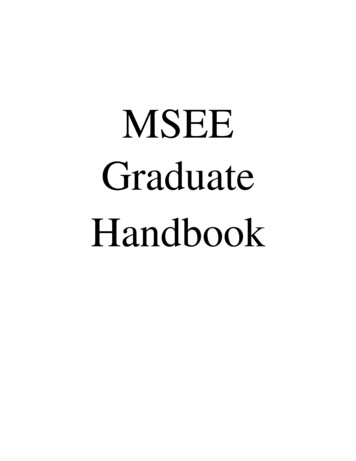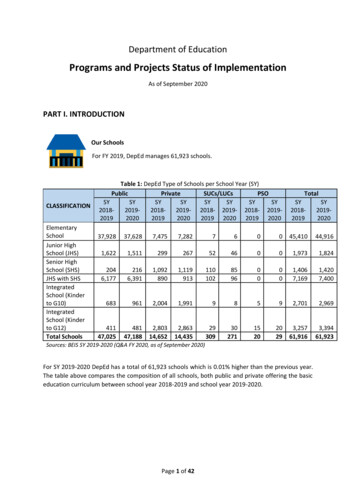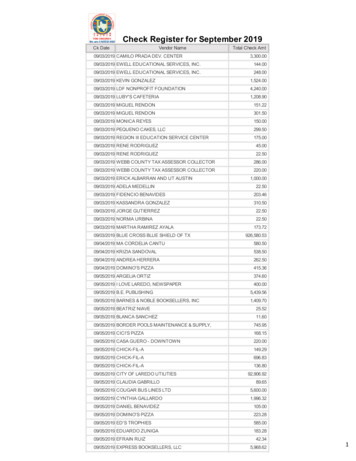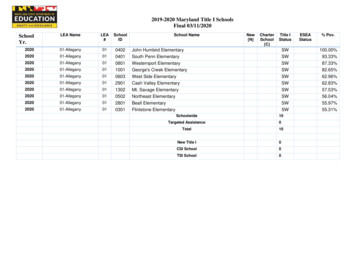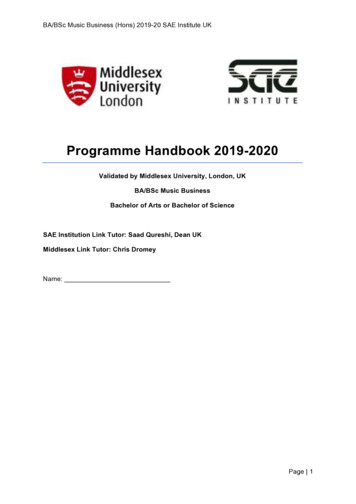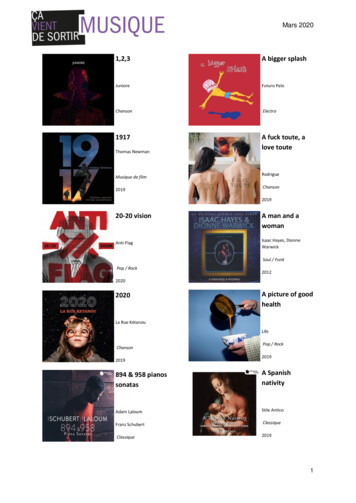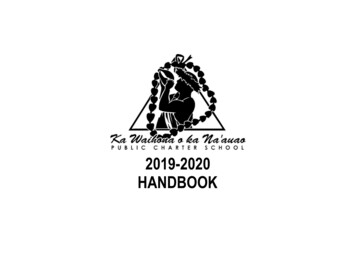
Transcription
2019-2020HANDBOOK
Ka Waihona o ka Na’auao:The Repository of LearningMISSIONKa Waihona o ka Na’auao creates sociallyresponsible, resilient and resourceful youngmen and women, by providing anenvironment of academic excellence, socialconfidence and cultural awareness.Papa Hula dancers hula for ali’i on the grounds of Mauna ‘Ala. Here, Princess RuthKe’elikōlani is honored for her steadfast aloha for her people and Hawai’i.
Section 1HO’OULU: Our Vision and Mission in ActionACADEMIC TENETWe are committed to academicdevelopment of our school communitythrough high expectations andcomprehensive support.PURPOSE:Ka Waihona oa ka Na’auao will offer a schooling experience for Wai’anaecoast children that is a viable alternative to the existing conventional publicschool model. Our school will be structured to be responsive to the learningstyles, cultural values, and future desires of the families of our community. Itwill emphasize a caring collaborative environment for all persons within theSOCIAL TENETschool community. It will include students, teachers, parents, other staff andWe are committed to developing socialconfidence and character within our schoolcommunity through a clear code of ethicsbased on our Nā Mea Waiwai.voluneteers, and community members implementing an effective and relevantCULTURAL TENETOur students are prepared to excel in intellect, in personal relationships, inWe are committed to honoring the valuesof our ancestors, which will guide ourstudents in building a strong future.social responsibility, and in wisdom. They are literate, competent, motivated,educational experience.VISION:and confident--with their potential for excellence grounded in their sense ofself-reliance acquired through relationships with the natural environment, thedeep culture of partnering with nature, and in possessing a strong sense oftime, place and culture.In collaboration with Mele Murals and the Estria Foundation, students led the design, creation and painting of a mural located atKalaniana’ole Beach Park, honoring the waiwai or richness of Nānākuli. The entire student body and school community joined inthe completion of this mural. Papa ‘Ewalu composed a mele that is included on the mural entitled, Nānākuli Ea.2
HISTORYIn 2000, Wai’anae community members recognized the need foran alternative educational option for the Wai’anae community andsubmitted an application for a charter school. In 2001, KaColleges (WASC). Through this process, the school will worktowards continuous school improvement of WASCrecommendations through the school year 2019-2020, uponwhich the next process of accreditation will begin.Waihona o ka Na’auao charter was granted by the State ofDuring the 2015-2016 school year, Ka Waihona began theHawai’i. In 2002-2003, the school was established in a chickenprocess of charter school renewal with the State Hawai’i Chartercoop in Wai’anae with a student enrollment of 68. ThirteenSchool Commission. The school was granted a three year contactfaculty and staff were employed to service five classes in gradesbetween 2016-2017, 2017-2018, and 2018-2019. In theK-3. In 2003-2004, the school was relocated to Mākaha in the2019-2020 school year, the school will apply for contract renewal.refurbished former Cornets, with a student enrollment of 128students in grades K-4. There were 15 faculty and staff thatserviced seven classes.In the 2018-2019 school year, the school expanded by adding aBlended program. Students in the program completed onlinecourse work via Harmony Educational Services and attendedKa Waihona o ka Na’auao has been situated in Nānākuli on theschool once a week to complete resource classes. In theDepartment of Hawaiian Homelands since 2004. The school has2019-2020 school year, the Blended online courses and resourcedeveloped a working partnership with DHHL and was granted aclasses will be offered on the current Nānākuli campus. The35 year lease. Adding a class per year since then, with threeschool’s Governing board will analyze and evaluate the programclasses per grade level, the school will enroll approximately 674at the conclusion of the school year, to determine if thisstudents in grades K-8, and 98 faculty and staff.expansion continues to be a need of the school community.In 2012, the school celebrated it’s tenth year anniversary. KaWaihona has been honored through accolades in the areas ofDistinguished Achievement by the Department of Education,Annual Yearly Progress, robotics, media, performing arts, healthand nutrition, and by it’s many community partners. In the2014-2015 school year, Ka Waihona achieved six yearaccreditation through the Western Association of Schools and3
CONTINUOUS SCHOOL IMPROVEMENT THROUGH WASCWASC RECOMMENDATIONSSince 2014-2015 school year, Ka Waihona has been an Ka Waihona to continue to work to implement the School Wideaccredited school through the Western Association of SchoolsAction Plan goals as re-prioritized in the Special Progressand Colleges, earning a six year accreditation status. AReport. Here is a summary of each goal.substantiated change was submitted in the 2018-2019 schoolyear to include the expansion of the school’s Blended program,administrative changes enacted by a new Transitional GoverningBoard, and the designation as a Targeted Supports and Goal 1: Develop and implement a decision making processusing data to inform all school wide decisions. Goal 2: Administration provide opportunities to implementImprovements school under the State’s Every Student Succeedscommon teaching practices identified in the BERC teacherAct. This designation addresses the targeted sub-groups thatevaluation system.scored in the lowest 10% of sub-groups for two consecutiveyears. Goal 3: Administration and faculty develop a plan to supportcurriculum and improve proficiency in achievement data,WASC COMMENDATIONS The faculty, staff and school community for their commitment toespecially in HSA Science, through alignment of instruction. Goal 4: The school create assessments to address the school’sthe school and their willingness to do whatever it take to raisesocial and cultural tenets through rubrics and student self-the bar for the benefit of their students.reflections. The Leadership Team and Accreditation Consultant for the effort Goal 5: The Governing Board and Principal work proactivelyput forth to create the Action Plan as well as the Specialwith Hawai’i Government Employees Association and all otherProgress Report.agencies to place Vice-Principals to the appropriate labor The Transitional Governing Board for the willingness to engagein frank discussions and work proactively to regain the trust andconfidence of the school community.contract. Goal 6: The Governing Board and Administration involve theschool community in determining the school model to increasecapacity to address the demand for more student enrollment.4
PARTNERSHIPSKey partners have contributed to the school’s growth andcontinue to join Ka Waihona in serving the community throughinnovative and rigorous education. Ka Waihona partners withorganizations and institutions who share commonality through the Kamehameha Schools: Ho’olako Like, Kanaeokana, Ka Pua,Kealaiwikuamoo, Kealakulia, Kuamahi, Preschools Leeward Lions and Rotary Club Mālama Learning Centerschool’s mission. Here are some of our community collaborators. Mana Maoli, Mana Mele Baker Evaluation Research Consulting (BERC) Nā Lei Na’auao The Bennett Foundation Nāwahīokalani’ōpu’u BUCK Institute for Education Office of Hawaiian Affairs Department of Education Office of Hawaiian Education Department of Hawaiian Homelands Palehua Estria Foundation PLACES and PALS Generation Schools Network Lili’uokalani Trust Hawai’i Association of Independent Schools University of Hawai’i- Mānoa HCAP Head Start University of Hawai’i-West O’ahu His Highest Praise Holani Hana Kaho’iwai5
IDENTITYDepartment of Education schools, public Charter Schools, andindependent schools alike.As depicted in the school logo, Ka Waihona students and alumnisignal a call to all people. The lei kukui is a symbol ofenlightenment, and reflective of na’auao, or wisdom, asembedded in our school name. The points of the triangle arerepresentative of students, parents and teachers working inlōkahi. The three points dually symbolize our mission’s academic,social and cultural tenets.Ka Waihona o ka Na’auao has many special meanings. The twomain words in the school name include waihona and na’auao.The word na’auao can be broken up into two words. Na’auThe school colors are brown, red and gold. Each colorrespectively represent ‘āina (brown), aloha for the native culture ofHawai’i (red), and enlightenment (yellow).means gut, of the heart, of the mind, and of our instinctualIt is Ka Waihona’s hope that students will be messengers whofeelings that guide us. The second half of na’auao is ao meaningshare and apply knowledge, skills, and character to uplift self,dawn, to grow light and to regain consciousness. Na’au and ao‘ohana, Wai’anae, lāhui Hawai’i, state, country, and global world.placed together means learned, wise, knowledge, enlightened,and literally daylight mind. The word waihona is a repository,closet or vault. When placed together in the ‘ōlelo no’eau (wisesaying of kūpuna), Ka Waihona o ka Na’auao is not only a placewhere learning is safely kept, but it is said in admiration of alearned person.Ka Waihona is home to Nā ‘Elele, The Messengers. Haumānaand alumni Nā ‘Elele are recognized for their character, readinessand skills to achieve, when they go on to attend public6
Section 2HANA: Nā ‘Elele ConductDISCIPLINARY POLICYNĀ MEA WAIWAIStudents demonstrate thesevalues to represent self, school,community, ‘ohana and kūpuna.With Nā Mea Waiwai as a foundation to student behavioralexpectations, student conduct will be reflective of our mission’ssocial tenet. We are committed to developing social confidence andcharacter within our school community through a clear code ofHŌ’IHI, RESPECTKULEANA, RESPONSIBILITYMĀLAMA, CARE AND SAFETYHA’AHA’A, HUMILITYLŌKAHI, UNITYHO’OMAU, PERSEVERANCEALOHA, LOVEethics based on our Nā Mea Waiwai. Administration will considerstudent behavior and special circumstances as necessary in allincidences, and implement the Department of Education PublicSchools Chapter 19 discipline. In the 2019-2020 school year theschool will continue to create assessments to address the school’ssocial and cultural tenets through rubrics and student selfreflections. Documentation for discipline offenses will be in Teacherlogs for grades K-4, in Teacherease for grades 5-8, and in theelectronic Comprehensive Student Support System, eCSSS, asapplied in the integrated system for the Hawai’i DOE.Besides academic requirements, Papa ‘Ewalu students are expected to meet all behavioral expectations during their8th grade school year in order to participate in all graduation activities, ceremony and events.7
CLASS ADISCIPLINEREFERRALCLASS BDISCIPLINEREFERRAL1st offenseclassroom levelconsequenceTeacher2nd offenseafter schooldetention scheduledCounselor3rd offensesuspensionAdministrationAdministration1st offenseautomatic 1-5 dayssuspension*Warning of suspensionon next offenseAdministration2nd offensesuspension*Warning of long term suspensionon next offenseAdministration3rd offenselong term suspension*Create a plan and implementationfor long term suspensionClass A Offense: alcohol, burglary, dangerous weapons,Class B Offense: harassment (verbal, physical, sexual, sexualdangerous instruments, drug paraphernalia, marijuana ororientation, racial), gambling, theft, bullying, cyber bullying,concentrate, property damage, terroristic threatening, assault,disorderly conduct, false alarm, forgery, gambling, hazing,extortion, firearms, murder, robbery, illicit substances, sexualinappropriate or questionable uses of internet material oroffensesequipment, trespassing*Ka Waihona will follow the DOE gun policy. There is a possible*Possession of tobacco product or electronic smoking device orpolice notification for all Class A offenses and warning ofuse of smoking or tobacco substancessuspension on next offense.8
CLASS CDISCIPLINEREFERRALCLASS DDISCIPLINEREFERRAL1st and 2ndoffenseclassroom levelconsequenceTeacher1st and 2ndoffensewarningTeacher3rd offenseafter schooldetention scheduledCounselor3rd offenseclassroom levelconsequenceTeacher4th offenseaction plandeveloped andmonitoredCounselor4th offenseaction plandeveloped andmonitoredTeacher5th offenseaction planconsequencesimplemented5th offenseaction ass C Offense: Abusive language, class cutting,Class D Offenses: cheating, contraband items, other schoolinsubordination, laser pen/ laser pointer (possession or use of),offenses, minor problem or behaviorleaving campus without consent, truancy*No disciplinary action amounting to serious discipline shall be*Gum chewing, cell phone use before or during school, disrespect,imposed for violation of any individual school rule as a class Dabusive language, dress code violations, inappropriate language,offense.lying, physical contact, property misuse, use of social media duringschool hours or school events, inappropriate use of technology,tardy (grades 6-8), teasing and taunting9
GRADE K-5 SUSPENSIONEXPECTATIONS Classwork, Homework Assignmentsand Projects: On the first day backfrom suspension, the student will be Projects: If a project is due during asuspension, it must be dropped off atIPods, MP3 Players, IPads, Tablets,the Admin office on the designated dueetc.)date. Assessments: Any assessments thatprovided all missed assignments andinclude quizzes, tests or exams missedwill be expected to turn in projects.during suspension will need to beStudents are required to complete allmade up on the first day back to class.assignments for full credit. Assessments: Any assessments thatinclude quizzes, tests or exams missedduring suspension will be made upduring the week the student returns toschool.GRADE 6-8 SUSPENSIONEXPECTATIONS Classwork or Homework Assignments:On the first day back from suspension,the student will need to request forclasswork or homework assignedCONTRABAND1. Large amounts of money2. Valuable personal items3. Toys (accessory type included) andballs4. Guns and accessories (not exclusiveto BB, water, air or paintball, etc.)*Class A Offense5. Gum or candy6. Medication (Prescribed or Holistic)during suspension from each individualteacher. Students are required tocomplete all assignments missed for8. Electronic devices (game systems,7. CosmeticsINAPPROPRIATE USE OFTECHNOLOGYStudents are expected to utilizetechnology to complete assignments andto communicate responsibly andappropriately for all school related use.Students will be required to complete theAppropriate Use of Technology Contract.Replacement fees may apply. Teacherswill assign devices to monitor studentuse. The school will monitor internet useof all students for appropriate use.Inappropriate use of School TechnologyDevices will fall in Class C or Bdiscipline.Class C: Off task search, inappropriateuse or horseplay using device1. 1st, 2nd and 3rd offenses will be aclassroom level consequence, Teacherreferralpartial credit.10
2. 4th, 5th and 6th offenses will be after school detention,Counselor referral3. 7th offenses will be a suspension, Admin referralClass B: Searching for the content of: drugs, alcohol, violenceand sexual nature, intentional misuse, logging into anotherindividual’s school account1. 1st offense will be after school detention, Counselor referral2. 2nd offense will be suspension and meeting with parents,Admin referralSCHOOL ATTIRE1. Students are required to wear the school uniform MondayThursday. Grades K-5 will wear a gold uniform t-shirt. Grades6-8 will wear a red uniform collared shirt. All students will usestudent issued ID’s for lunch, field trips and daily uniform.2. Friday is an appropriate and free dress day.3. Pants, shorts, or skirts must be worn at the waist.4. Shorts, skirts or dresses should be modest in length and fit. Ingrades 6-8, attire should be no more than 5 inches above theknee in a standing position.5. Buttoned or zippered jackets or sweaters are allowed. School6. Clothing should be clean and neat.7. Footwear is required with a maximum of a 1 inch heel. Nowheeled shoes will be permitted. Students must be able to tieshoes.8. PE uniform shirt and shorts are required for PE in grades 5-8.PE shorts may be worn outside of PE. PE shirt may not beworn outside of PE. Athletic shoes are required at PE for K-8.UNACCEPTABLE SCHOOL ATTIRE1. Picture images that project violence, nudity, drugs, alcohol, oroffensive language or phrases on clothing2. Modification to school uniform that includes cutting or writing3. Shirt or blouse straps less than 1 inch4. Strapless, backless, exposed midriff, halters, spaghetti straps,low cut or low back tops5. Shirts or pullover sweaters over the uniform shirt6. Overly large, tight or small clothing7. Sheer tops without undershirt or camisole8. Pants, jeans, shirts, shorts or skirts with extreme see throughholesuniform or appropriate top should be visible beneath outerwear.11
9. Sunglasses, hats or hoods at protocol or indoors10. Pajamas11. Make up for grades K-5. Grades 6-8 may wear modestmake-upParents should drop off appropriate attire if necessary. If theattire is not corrected by 9:30am, a student uniform will be issuedand parent will be billed. Options for student issued uniformsinclude collared shirt or PE shorts for GR 5-8, and uniform t-shirtfor GR K-4. Student will return to class upon correction of attireat this time. If no correction is made by 9:30am student will not12. Dangling earrings or tapers (studs only allowed)be allowed to return and must be picked from the office.13. Visible piercings other than ear piercingsFIELD TRIP ATTIRE14. Only one each: earring set, necklace, anklet, bracelet, ringClass or Grade Level: White uniform collared shirt, shorts or15. Rub on tattoos (students will wash off)pants, covered shoes; attire for physical or outdoor field trips to16. Temporary hair paint or permanent loud dye during schoolevents or programsDRESS CODE VIOLATIONSbe determined by teacherMauna ‘Ala: White uniform collared shirt, black shorts or pants,slippers, no jewelry or accessoriesKūkulu Kumuhana: GR K-5 gold uniform shirt, GR 6-8 redDress code violations are a Class C offense. Class C disciplineuniform collared shirt, black shorts, bathing suit for girls underpolicy will apply.clothing, slippers, no jewelry or accessories1. Homeroom teacher will check attire and make student referralATTENDANCEto the Admin office during homeroom. Student referrals afterhomeroom will be handled on a case by case basis.2. If in violation, student will remain at the Admin office until attireAcademic achievement and success is greatly impacted by astudent’s attendance. Absences, tardiness and early releaseminimize a student’s instructional time creating barriers foris corrected. Office will assist student in calling parent toteachers to build skills and cover curriculum to progress studentscorrect attire by 9:30am.individually and the class as a whole. School policy and12
procedure regarding attendance can be found in Section 7:Ke’ena, Administration Office. Student will defend a portfolio presentation and meetproficiency through an 8th grade defense.LOITERING AFTER SCHOOLDiscipline RequirementsUnsupervised students after school will be required to leave Student will not commit any Class A or B offense in semester 2campus at 3:00pm Monday-Thursday and 1:30pm Friday.Waiting next to the school parking lots will not be allowed afterthese times. Students will call parents for pick up and attend A until parent arrives. A fees will apply.8th GRADE GRADUATE EXPECTATIONSParticipation in Ka Waihona 8th grade graduation ceremony anddesignated end of year class activity is a privilege. Failure to meetany requirement will be reviewed case by case by Administrationin grade 8Lei Kāmoe and Graduation Attire Requirements Student will complete lei kāmoe as assigned in Papa Hula priorto the Graduation Ceremony Student will pay a non-refundable and non-transferrablepayment for lei kāmoe tools and supplies Student will pay a non-refundable and non-transferrableand may result in non-participation in the graduation ceremony, orpayment for graduation attire and receive attire regardless ofend of year class activity, or not receiving certificate ofparticipation in ceremony.completion. 8th grade requirements include:Academic Requirements Student will be promoted to 9th grade at the end of the 8thgrade year with no credit recovery necessary Student will pass all core classes of Math, Language Arts,Social Studies and Science earning a 60% or above for the year All fees are non-refundable regardless of student participation inthe ceremonyFinancial Obligation RequirementsAll fees need to be paid in full by the first business day in May.Fees may include books, supplies, field trips, lei kāmoe, andgraduation attire costs.end grade.13
School Wide Cultural Events and Field Trip RequirementsCredit Recovery Requirements Student will attend and participate in school wide cultural Teacher will inform parent of failure to earn credit for a classevents (Mauna ‘Ala, Makahiki, Ma Ka Hana Ka ‘Ike, Ho’olale i ka‘ai a ka u’i, Kūkulu Kumuhana, etc.) Student will attend and participate in grade level scheduled fieldtripsFundraising and Volunteerism RequirementsStudent will participate in fundraising and volunteerism to assistthe class in efforts to raise money for class activity andgraduation. Failure to meet requirements will result in one or moreof the following:1. Non-participation in designated class activity2. Non-participation in graduation ceremony3. No certificate of completionduring the last two weeks of school. Academic Counselor will verbally contact parent during the lastweek of school to inform parent of credits not earned. Studentwho has not earned the minimum required credits will beretained. This status will be reflected in student report card. Parent will inform school of credit recovery program by the lastday of school. Academic Counselor should receive credit recovery results oneweek prior to the start of the next school year. Results will becommunicated to parent and Registrar. The change topromotion status on student report card will be made, asnecessary. Any student who must complete credit recovery will notparticipate in graduation ceremony and end of year activity, will4. Payment of all fees applicable to grade 8 studentsTransfer Requirementsnot receive an 8th grade certificate of completion, and will notbe able to repeat grade 8 at Ka Waihona.Parent will inform the school in writing of next attending schoolbefore the last day of school.14
Section 3‘ŌIWI: Native CultureAt the end of the 2007-2008 school year, papa ‘ewalu students prepared hulu, created aAt Ka Waihona,design, and wove a lei kāmoe. It was a process that required patience, diligence, andlayers of cultural‘ohana hear the chant, He Lei Kēia Nou E Ka Waihona, and look on as graduates adorncurriculum,programs, andevents evoke deeplearning and selfreflection. Webelieve this sets ourstudents up forgreat self discoveryand achievementthroughout life.hard work. The lei kāmoe concludes each Nā ‘Elele journey. Every year since then,themselves with a lei kāmoe at ‘Ilikūokalani, the school’s pā hula, for the final time.In the 2014-2015 school year, papa ‘ewalu students were the first class to defend aportfolio. Students were tasked with identifying Nā Mea Waiwai that described growththrough a selected learning artifact within their portfolio. A presentation was made to apanel comprised of a faculty advisor, faculty leadership member, community member, anda seventh grade student. Each presentation was given a proficiency, honors, or resubmitevaluation. The process of defense portfolio is now a traditional rite of passage for allexiting Ka Waihona eighth graders. In the 2018-2019 school year, Ka Waihona completedfive years of defense portfolio presentations with 100% of students meeting proficiency.15 eighth graders were distinguished and met proficiency with honors.Located on Department of Hawaiian Homelands in Nānākuli, Ka Waihona o ka Na’auaoserves the largest concentration of Native Hawaiians in the world through education.Each year on average, 94% of the student body are Native Hawaiian. Learning aboutone’s culture connects, excites and impacts powerfully. Through these experiences,students begin to see how wisdom of kūpuna continue to be apart of who they are today.More and more, they are able to make connections with the past, the present and thefuture.Students learn the uses of lā’ī during Ma Ka Hana Ka ‘Ike, our school program that includes mini cultural workshops, pilina opportunities witholder and younger students, and authentic products such as this kūpe’e, being binded between an elder and youngest haumāna.15
NĀ MEA WAIWAIDAILY PROTOCOLare school core values that setbegins each school day. All Kumu greetbehavioral expectations. These valuesstudents, lead announcements andoriginate from kūpuna who throughpledges. The school then unifies intraditions and practices, demonstratehīmeni of traditional mele. Studentsways of kūpono living. Students arecenter themselves with the request toexpected to strive, apply and reflect onenter school with an oli kāhea. When inNā Mea Waiwai through all learningagreement, Kumu will accept the requestexperiences and interactions.to learn through oli komo. The entireKUMU HULAAdministration, faculty, staff and studentbody practice protocol to center andis a master teacher who passes onrealign themselves for a day of learningtraditional knowledge received from aahead.hula lineage after completion of an ‘ūnikiprocess. Besides hula, mele and oli,WELCOME PROTOCOLknowledge of costumes, plants, andis a formal greeting to school guests.protocol is a part of a Kumu Hula’sStudents and Kumu Hula prepare lei, oli,kuleana. Ka Waihona’s Papa Hulamele and or hula to demonstratedepartment originates from one hulahospitality and to honor the purpose oflineage. The Kumu Hula leads schoolthe visit.wide hula classes, cultural protocol, andassists in school wide cultural programs.MAUNA ‘ALAis the final resting place of theKamehameha and Kalākaua Dynasty. Kafamilies and travel to Nu’uanu to offer lei,ha’i ‘ōlelo, hīmeni, oli and hula. Studentsshow reverence and reflect uponqualities of leadership as seen in belovedali’i.MAKAHIKIseason traditionally covers fourconsecutive lunar months, from Octoberor November through February or March.Kanaka stopped work, made offerings toaliʻi, and then spent time practicingsports, feasting, and dancing. War waskapu. Students will learn about this timeof year and culminate it in a school wideMakahiki sports festival.MA KA HANA KA ‘IKEis to learn by doing. At this school event,Kumu hold cultural workshops andstudents in upper grades partner withlower grade students to learn traditionaland contemporary Hawaiian practices,side by side.Waihona honor ali’i from these royal16
HO’OLALE I KA ‘AI A KA U’Iallow students to perform for ‘ohana andschool community in the school’s annualhula festival. All students hula, hīmeni,oli and attend Papa Hula weekly inpreparation for this hō’ike. A selectedali’i, kanaka, or wahi pana is honoredthrough ha’i ‘ōlelo, hula, mele, hīmeni,representing the sea, and kalothrough an introspective look at self andrepresenting the land, sprinkled with‘ohana by means of mo’okū’auhau orpa’akai for protection and blessings.genealogy. From grades K-6, studentsStudents enter the kai or sprinklego back in time and uncover maternalthemselves with salt water, under theand paternal parts of their ‘ohana.care of the Po’okumu, Papa Hula, KumuAdditionally, students study theand certificated lifeguards, to concludemo’okū’auhau of nā ali’i. Thethe school year as a school ‘ohana.culminating event is the school’s Maunaand oli.PIKOGRADUATION LEI CEREMONYoccurs quarterly for faculty and staff. Itsymbolizes the conclusion of Nā ‘Elele’sjourney. ‘Ohana hear the chant, He LeiKēia Nou E Ka Waihona, and barewitness, as graduates adorn themselveswith a lei kāmoe. Each eighth gradestudent prepares and weaves a leikāmoe to culminate the completion ofstudy at Ka Waihona.KŪKULU KUMUHANAmarks the end of the school year. Theschool pools together it’s strength toreflect and celebrate goals achieved. Atthe kahakai, haumāna partake in ‘opae,is a time for Kumu to come together,unify through traditional practices, andenjoy fellowship.PAPA ‘ŌLELO HAWAI’Iis a required elective class for all seventhand eighth graders. Students areintroduced to Hawaiian language andcomplete a project that is exhibited forpeers and ‘ohana at the end of each‘Ala program held in Nu’uanu at theRoyal Mausoleum.In quarter 2, students study Makahiki,practices of the season, and everydayliving. The culminating event is a sportsfestival hosted by upper grade classes.Students compete against one anotherand Kumu join in the fun.Quarter 3 and 4 uncover thematic units‘āina momona and kai momona.Students study traditional practices andways of living, ecosystems, and geologyyear.associated with riches of uka and kai.THEMATIC UNITSINDIGENOUS CONFERENCESwere designed and aligned by gradeare opportunities for haumāna, kumu andlevel Kumu. Quarter 1 takes studentsPo’okumu to learn and share from others17
who support and continue to develop innovative indigenouseducation. Partnerships have helped Ka Waihona grow, identifyand implement strategies to reach students through a cultural and21st century lens.18
Section 4‘IMI NA’AUAO: Seeking KnowledgeWASC ACCREDITATIONPE’APE’A MAKA WALUEIGHT-EYED PE’APE’AONE WHO IS WIDE AWAKE AND VERYOBSERVANT; ONE WHO IS SKILLED.PE’APE’A WAS THE SON OFKAMEHAMEHA NUI OF MAUIThe Western Association of Schools and Colleges accredits schools through arig
HO'OULU: Our Vision and Mission in Action 2 ACADEMIC TENET We are committed to academic development of our school community through high expectations and comprehensive support. SOCIAL TENET We are committed to developing social confidence and character within our school community through a clear code of ethics based on our Nā Mea Waiwai.
